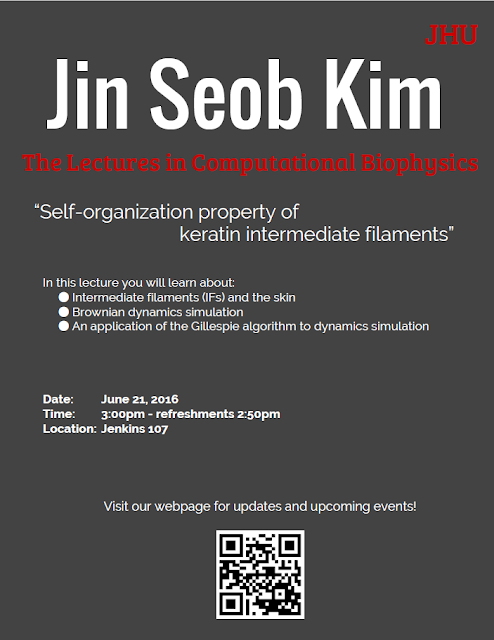How do Keratin Intermediate Filaments self-assemble?
 |
| Skin epidermal layers [2] |
Intermediate filaments (IFs) provide structural and mechanical support vitally important to maintenance of cell and tissue integrity under stress. In vitro studies established that IFs must be crosslinked into a network in order to generate the elasticity and mechanical properties consistent with their mechanical support role in living cells. Accordingly, keratin IFs are typically organized into large bundles in epithelial surface. Skin epithelial cells express type I and type II IF genes, whose protein products copolymerize to form 10-nm-wide IFs in their cytoplasm. Experimentally, various types of keratin IFs are able to self-organize into crosslinked networks at subphysiological concentrations. For IFs comprised of keratin proteins 5 and 14 (K5, K14), found in basal keratinocytes of epidermis, bundling can be self-driven through interactions between K14's carboxy-terminal tail domain and two regions in the central α-helical rod domain of K5.
A number of fundamental questions remain about the pathway through which the keratin IF surface can promote the crosslinked network formation. In their work, Jin Seob Kim, Chang-Hun Lee and Pierre Coulombe from Johns Hopkins exploit theoretical principles and computational modeling to investigate how IF crosslinking happens. In their simple model, keratin IFs are treated as rigid rods to apply Brownian dynamics simulation. The authors' findings suggest that long-range interactions between IFs are required to initiate the formation of bundle-like configurations, while tail domain-mediated binding events act to stabilize them. The simple model explains the differences observed in the mechanical properties of wild-type versus disease-causing, defective IF networks. This effort extends the notion that the structural support function of keratin IFs necessitates a combination of intrinsic and extrinsic determinants, and makes specific predictions about the mechanisms involved in the formation of crosslinked keratin networks in vivo.
Theoretical time evolution of bundle formation [1].
Jin Seob's Article:
[1] Kim, Jin Seob, Chang-Hun Lee, and Pierre A. Coulombe. "Modeling the self-organization property of keratin intermediate filaments." Biophysical journal 99.9 (2010): 2748-2756.
References:
[2] Matsusaki, Michiya, et al. "Development of full‐thickness human skin equivalents with blood and lymph‐like capillary networks by cell coating technology." Journal of Biomedical Materials Research Part A 103.10 (2015): 3386-3396.
[3] Lee, Chang-Hun, and Pierre A. Coulombe. "Self-organization of keratin intermediate filaments into cross-linked networks." The Journal of cell biology 186.3 (2009): 409-421.
_________________________________________________________________________________
 Dr. Jin Seob Kim received a B.A. degree and M.S. degree in mechanical engineering from Seoul National University. After his master’s degree, he worked as a research engineer at SAMSUNG Electronics. In 2006, he received his Ph.D. degree in mechanical engineering at the Johns Hopkins University under the supervision of Dr. Gregory S. Chirikjian. After graduation, he worked as a postdoctoral fellow under the supervision of Drs. Sean Sun and Pierre Coulombe in the projects on computational cell morphology, cytoskeletal filaments, and skin homeostasis. Currently, he is an assistant research professor in the department of mechanical engineering at the Johns Hopkins University.
Dr. Jin Seob Kim received a B.A. degree and M.S. degree in mechanical engineering from Seoul National University. After his master’s degree, he worked as a research engineer at SAMSUNG Electronics. In 2006, he received his Ph.D. degree in mechanical engineering at the Johns Hopkins University under the supervision of Dr. Gregory S. Chirikjian. After graduation, he worked as a postdoctoral fellow under the supervision of Drs. Sean Sun and Pierre Coulombe in the projects on computational cell morphology, cytoskeletal filaments, and skin homeostasis. Currently, he is an assistant research professor in the department of mechanical engineering at the Johns Hopkins University.
Dr. Kim’s research interests lie in mathematical modeling and simulation in the broad areas ranging from biology (molecular to cellular biology, systems biology and mechanobiology) and engineering (robotics and dynamics).
Dr. Kim has published highly cited 9 first author papers and co-authored 4 papers in peer reviewed international journals. Also he has published 4 peer-reviewed papers in highly cited international conferences on robotics and computational biology.





